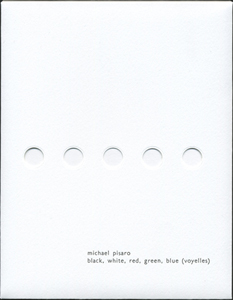 Released earlier this year as a single 120 minute cassette, the two variations on Pisaro's composition for guitar, performed by Barry Chabala, appears as a gorgeous new two CD reissue on the Winds Measure label. While it may lose a bit in its transition from analog to digital, the clarity of the CD format actually enhances the contrast between the two separate versions.
Released earlier this year as a single 120 minute cassette, the two variations on Pisaro's composition for guitar, performed by Barry Chabala, appears as a gorgeous new two CD reissue on the Winds Measure label. While it may lose a bit in its transition from analog to digital, the clarity of the CD format actually enhances the contrast between the two separate versions.
"Black, White, Red, Green, Blue" is an hour long, five part composition for electric guitar that is focused on specific tones, but was open to interpretation by the performer as far as tempo and pacing goes.Besides the notes used, each part differs with the method of guitar playing utilized.For the first part, a soft, repeating malleted chord is used, almost mimicking a tolling church bell that conjures a lot of warmth in its sparseness.
For the second movement, the piece shifts to light, gliding tones from single played notes.The dynamics shift from quiet to almost silent, with long passages of actual silence between the sounds.By the third movement, the sounds moves more into actual pseudo-chords while retaining its long gaps of silence.The depth and intensity builds as Chabala switches to an ebow, staying low but into thicker, vibrating moments before switching back to a mallet, resulting in an ending similar to the opening.
Most of the original piece remains intact on the second piece, "Voyelles," but processed cassette tape hiss and other incidental sounds gleaned from that dated format are added in.While "Black, White…" was sparse and pure, "Voyelles" is a bit more ragged and messy in the best possible way.Right from the onset, the repeated note is paired with a rough, grinding type sound of a cassette tape motor above it.
The sound of tape noise appears via slight processing throughout:soon the aforementioned motor sound is replaced by what sounds like tape hiss amplified to imitate surging rain, before reassembling into an almost painful, super high frequency like an ancient, slightly off-track audio tape.The addition of the analog noise pushes the piece into an entirely different direction, but never loses its original character.
"Black, White, Red, Green, Blue" in its original form surely benefits greatly from the clarity of the CD format, emphasizing the silent spaces and low tones with digital purity, something that may have been obscured in the original cassette format.On the other piece, however, the innate tape noise would have made each playing different depending on conditions and equipment.Even with the clarity, "Voyelles" works wonderfully, and I have to admit to favoring that version of Pisaro’s composition, the contrast between pure guitar and raw textural noise works perfectly.
samples:
 
Read More

